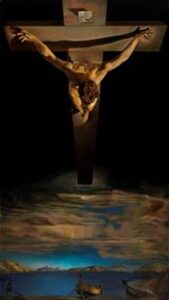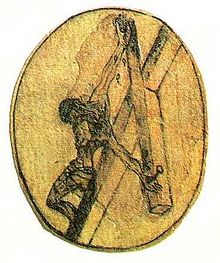By Canon Ian Morter

Question: What links, a painting of Lake Galilee, the ancient Spanish territory of Castile and the City of Glasgow?
The answer is the 20th Century surrealist painter Salvador Dali.

This painting I expect many have seen before. It is entitled Christ of St John of the Cross by Salvador Dali which has been in Collection of the Kelvingrove Art Gallery in Glasgow for the last 70 years.
The painting and intellectual property rights were purchased in 1952 by Tom Honeyman the then director of the Glasgow Museums, he paid £8,200, which was considered a high price at the time. There was a petition against the acquisition presented by the students of the Glasgow School of Art who argued that the money would be better spent on exhibiting local artists. This controversy precipitated Honeyman and Dalí to become friends, and they corresponded with each other for many years following the purchase.
But in December a time when we might well be focusing our thoughts on the last days of Advent if not Christmas itself, why am I asking you to reflect on a curious depiction of the crucifixion painted by Salvador Dali?
On Wednesday this past week the Church remembered an important Christian poet and writer who has had an important influence upon the Western Church. So great was that influence that 135 years after his death in 1591 he was declared a Saint and in the 20th Century made one of the Doctors of the Church. His name Juan de Yepes y Álvarez, better know as John of the Cross. St John of the Cross was a Carmelite monk whose monastery was in Castile. He corresponded, and was greatly influenced by the Carmelite nun, Teresa of Ávila, who was also honoured by the church as a prominent Spanish mystic and religious reformer. But St John’s poetry and his studies on the development of the soul are considered the finest examples of mystical Spanish writing and also among the greatest works of all Spanish literature.
Christ of Saint John of the Cross was painted by Dali in 1951 and depicts Jesus Christ on the cross in a darkened sky floating over a body of water complete with a boat and fishermen. Although it is a depiction of the crucifixion, it is devoid of nails, blood, and a crown of thorns, because, according to Dalí, he was convinced in a dream that these features would mar his depiction of Christ. Also in the dream, the importance of depicting Christ in the extreme angle evident in the painting was revealed to him.

So why is the painting known as the Christ of Saint John of the Cross? It because its design is based on a drawing by the same 16th-century Spanish Carmelite John of the Cross.
Dali explained his composition of Christ is also based on a triangle and circle (the triangle is formed by Christ’s arms; the circle is formed by Christ’s head). The triangle, since it has three sides, can be seen as a reference to the Holy Trinity, and the circle represents the unity and eternity, exemplified in Holy Trinity.
In notes written on his studies for the painting, Dalí explained his inspiration: “In the first place, in 1950, I had a ‘cosmic dream’ in which I saw this image in colour and which in my dream represented the ‘nucleus of the atom.’ This nucleus later took on a metaphysical sense; I considered it ‘the very unity of the universe,’ the Christ!”
Curiously in order to create the figure of Christ, Dali had Hollywood stuntman Russell Saunders suspended from an overhead gantry, so he could see how the body would appear from the desired angle and also envisage the pull of gravity on the human body. The body of water represent Lake Galilee but is actually the bay of Port Lligat, where Dalí’s had his home and studio at the time.
A few years ago I went to the Kelvingrove Art Gallery and Museum in Glasgow and for the first time saw the painting rather than a small scale print. Because of this visit the composition was intensified in its significance to me from the first print I purchased from Athena in the mid-nineteen seventies as an undergraduate. The original in Kelvingrove is displayed in a self-contained bay with a bench on which you can sit to meditate on this vision that links a 16th Century mystic writer and a 20th Century surrealist painter.
Whilst recently visiting The Rev’d Alison Turner, one time Priest Vicar here at Exeter Cathedral, I was discussing my idea of writing about John of the Cross and the connection with Salvador Dali, Alison remembered a poem she had learnt by heart that I think is a helpful reflection on this painting:
The Kiss of Christ
Lo, there He hangs –
Ashen figure pinioned against the wood.
God grant that I might love Him
Even as I should.
I draw a little closer
To feel His love divine,
And hear Him gently whisper
“Ah, precious child of mine –
If now I would embrace you,
My hands would stain you red.
And if I leaned to whisper,
My thorns would pierce your head.”
‘Twas then I learned in sorrow
That love demands a price;
“Twas then I learned that suffering
Is but the kiss of Christ.